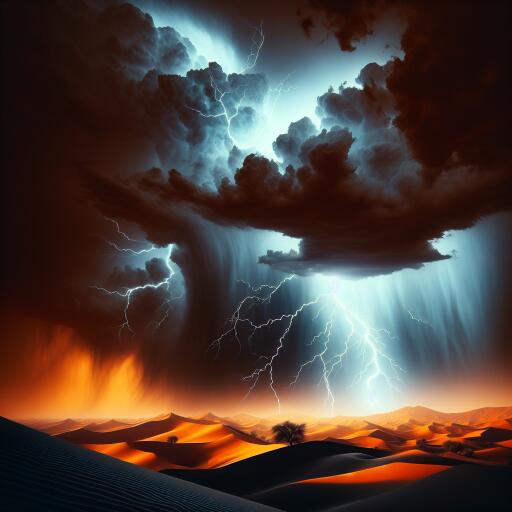
“`html
Thunderstruck in Thar
As the impacts of climate change become increasingly severe across the globe, Pakistan remains exceptionally vulnerable, plagued by extreme weather events that imperil lives, occupations, and economic stability. Despite contributing a minuscule portion to global carbon emissions, Pakistan ranks among the top five countries most susceptible to climate change, according to the UN’s Global Climate Risk Index.
April 2024 was a stark reminder of this vulnerability, as it marked the wettest month in decades, unleashing rain far above the norm and catastrophic lightning that claimed numerous lives. Reports reveal that at least 41 people succumbed to these violent storms, 28 of whom died from lightning.
The Sindh region, particularly Tharparkar, has borne the brunt of these lightning strikes, suffering significant casualties. According to the Provincial Disaster Management Authority – Sindh report, during the monsoon season of 2024, 14 people lost their lives, six were injured, and 257 livestock perished due to lightning.
Between 2019 and 2023, an alarmingly high toll of 98 individuals and 1,756 animals fell victim to lightning in Tharparkar, creating a persistent sense of unease among residents. Despite prevalent concerns, lightning continues to haunt the region with an inexplicable frequency, without clear reasons as to why Thar faces a more pronounced threat than other similarly affected regions in Pakistan.
This unsettling shift in weather patterns has transformed rain in Thar from a long-cherished blessing to a troubling source of anxiety. The traditional sowing season is now fraught with hindrances, adversely affecting the social and economic fabric and turning optimism into apprehension.
Unraveling this complex web of environmental challenges, it becomes evident that Thar is not an isolated case. Lightning strikes have surged not only across Pakistan but also in neighboring regions like India and Bangladesh. Scientists suggest that global warming may be escalating thunderstorm activity, thereby intensifying lightning occurrences. Rising global temperatures, specialists note, cause a rise in convective processes, leading to frequent storms and lightning. A mere 1°C increase can provoke a 12 percent rise in lightning incidents, as a warmer atmosphere retains increased moisture, thus enhancing storm severity.
Research from the University of California, Berkeley finds that ‘rising temperatures spark lightning since atmospheric water vapor — thunderstorms’ fuel — balloons with warming air.’ As the planet heats, these thunderstorms become more intense due to surplus energy.
Moreover, exploration by James Madison University highlights the effects of pollutants and aerosols on lightning, indicating that contaminants act as cloud nuclei, further complicating storm dynamics. Studies in India have assessed how particulates like pollution and dust could augment friction among particles, catalyzing more frequent lightning.
Although these insights illustrate possible catalysts contributing to increased lightning, there’s yet to be a comprehensive global understanding due to regional atmospheric disparities. Variables unique to certain locales significantly influence thunderstorm formation, complicating the larger puzzle of discerning precise causal elements.
The report “Climate Change Scenarios in Pakistan – A Case Study of Thar Sindh” underscores climatic alterations, noting that heightened surface air temperatures accelerate evaporation and elevate atmospheric moisture. Thus, erratic rain patterns are namely predicted for Thar, potentially becoming hotter with inconsistent precipitation.
Acknowledging these troubling tendencies indicates an urgent call for scientific discourse to evaluate how climate change connects with thunderstorms. Scientific, regional climate, and weather modeling research are imperative to decipher the variables at play and develop preventive strategies.
Localized in places like Tharparkar, the spike in lightning events necessitates investigative and pragmatic initiatives to unravel this enigma. The frequent lightning during the Thar monsoons could potentially be a complex blend of geographic, environmental, and climate variables. Confirming and understanding these influences could dispel myths and produce effective lightning mitigation strategies.
Given the socio-technical characteristics particular to developing countries like Pakistan, it’s crucial to ground safety guidelines in scientific validity. Implementing responsive alert systems, establishing lightning-proof shelters, and fostering effective emergency response mode are vital protective measures.
Local communities in Thar must bridge their knowledge gaps. Absent scientific awareness, people turn to unsubstantiated myths for protection. Public education initiatives offering factual knowledge and promoting safety measures could save lives and alleviate prevalent eco-anxieties.
Significant behavioral adaption is pivotal to confronting this evolving natural phenomenon. Raising awareness, teaching lightning safety, and encouraging community shelter use can significantly reduce vulnerability to this lethal weather event.
Tackling the formidable threat of lightning necessitates a unified effort among government entities, policy makers, NGOs, academic institutes, and society. A collaborative approach promises to implement strategic acts of adaptation and mitigation. The future beckons immediate action before the looming storm arrives.
“`





Leave a Reply